
Capitol inner sleeves
for 78 RPM, 45 RPM and 33 RPM records
Written by Serge Pelletier and Piers Hemmingsen with help from Ian Gosling
Capitol sometimes sold records directly in the carboard jacket, but often instead housed their records in generic paper inner sleeves. Some were quite plain while others were very colorful, promoting other albums or at one point, when stereophonic recordings were the new thing, explaining what "stereo" was and how it worked! Some albums even had the luxury of offering custom made inner sleeves. This list covers all the generic sleeves that Capitol offered through the years for both LPs and 45s for their exclusive Canadian series of records.
From the "Corporate History" page for Capitol of Canada, it is seen that the London Ontario operation spanned 1949-1956. The Toronto operation started in 1956 and is still going strong there as EMI. So you can see that Capitol sold a lot of records in Canada between 1949 and the 1990s and therefore there are many thousands of these cool sleeves out there !
78 RPM album inner sleeves
78 RPM stock company sleeve from Capitol London Ontario (1949)
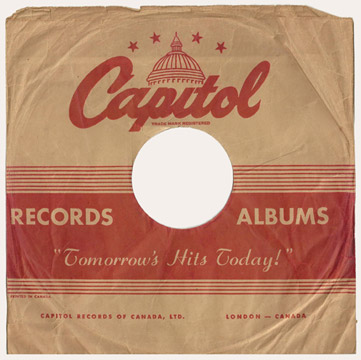
78 RPM stock company sleeve from Capitol London Ontario (circa 1951)
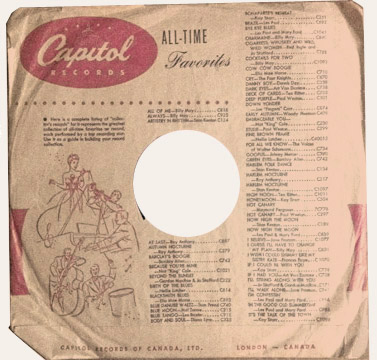
78 RPM stock company sleeve from Capitol for squaredance records
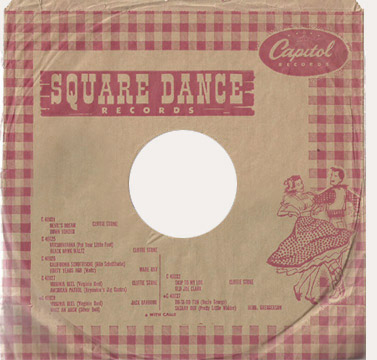
78 RPM stock company sleeve from Capitol London Ontario (pre 1954)

78 RPM stock company sleeve from Capitol Toronto Ontario (post 1954)
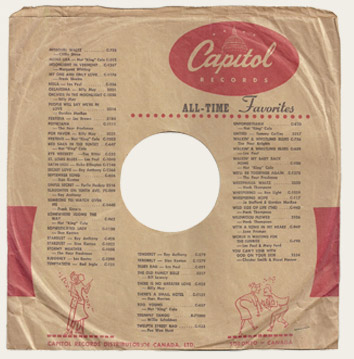
45 rpm singles sleeves
This London Ontario 45 RPM sleeve is pre 1954 and is identical on both sides
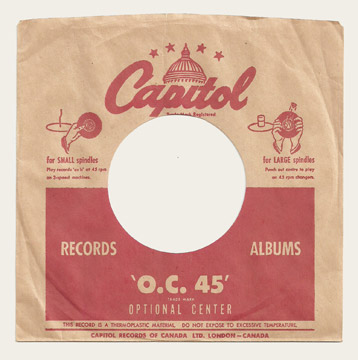
This London Ontario 45 RPM sleeve is pre 1954 and has slightly different sides

This Toronto Ontario 45 RPM sleeve is identical on both sides and appeared after November 1954
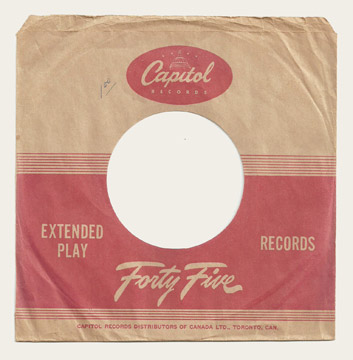
This Toronto Ontario 45 RPM sleeve is identical on both sides and is similar in design as the previous sleeve, but is made of thinner paper with vertical lines. This sleeve appeared around 1957 or 1958.

This pink sleeve is similar to its US counterpart, but has references to Capitol of Canada, Toronto on the bottom right. This sleeve was used for Canadian 45s starting in early 1959 and was probably used until release # 72016 in early 1962 where the purple label was then changed to the swirl label. Some early swirls were nevertheless still sold in this pink sleeve until they used them all up, which made an odd color mix!
Singles like Charlie Drakes "My Boomerang Won't Come Back" were sold in the black sleeve (see next entry), while its purple counterpart was sold in the pink sleeve. Harlan Howard's "She Called Me Baby" (Capitol 4682) and Glen Campbell's "Too Late To Worry, Too Blue To Cry" (Capitol 4783) both with swirl labels but in the pink sleeve.

Early swirl labels were accompanied by this glossy black Capitol sleeve and by the time of "Ramblin' Rose" by Nat King Cole (Capitol 4804) and "Come Outside" by Mike Sarne (Capitiol 72043) the black sleeves were here to stay. It was used until 1963. Early Beatles records and "Bachelor Boy" or "Summer Holiday" by Cliff Richard in the late spring '63, still had the glossy sleeves.

This flat black thin paper sleeve was used from 1963 until 1966. It was used with swirl labels without brackets.
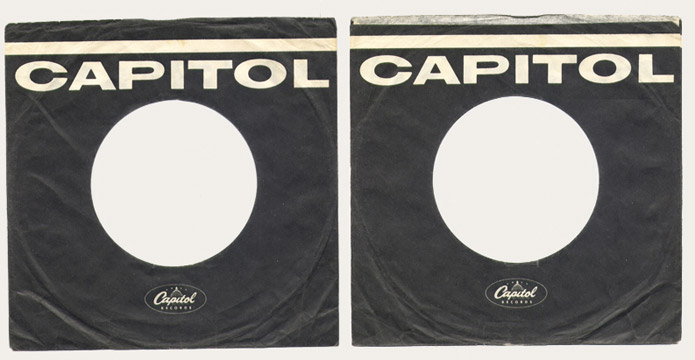
This black and white version of the Starline sleeve was used in Canada, listing other starline 45s issued in Canada, from 6001 to 6075. Needless to say, this sleeve was used with green swirl starline singles. The Canadian sleeve is printed with a black ink that tends to be more purple-ish than true black.
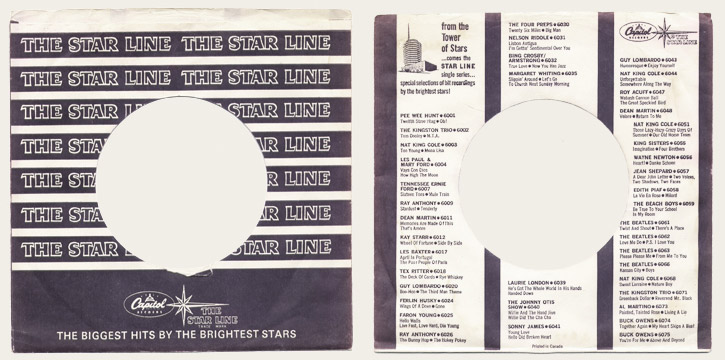
Another later similar sleeve was produced in Canada, but this one does not feature the four Beatles starline singles, instead, it lists the first six titles from the 22000 series. Some of the other titles are also different. Again, the Canadian sleeve is printed with a black ink that tends to be more purple-ish than true black. The sleeve is probably from 1967 or early 1968.
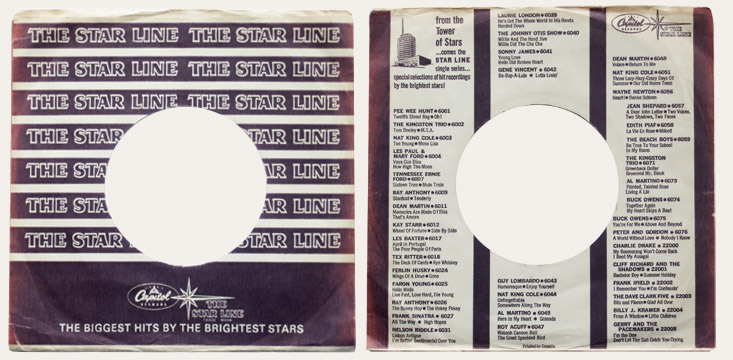
This white sleeve with the black border was used extensively in the USA but not in Canada. Here it was used for only a few months in the first half of 1966, likely February to circa May.
A few hit 45's that had this sleeve were Woman by Peter And Gordon (Capitol 5579), Time Won't Let Me by The Outsiders (Capitol 5573), At The Scene by The Dave Clark Five (Capitol 72324), Michelle by David and Jonathan (Capitol 5563) as well as Nowhere Man by The Beatles and most likely many others. By roughly May 1966 the sleeve with the angled multi "Capitols" (see next entry) came out and Canada never saw that white sleeve again.

In 1966, swirl labels were changed to the brackets version. After the short-lived white sleeve, Capitol of Canada preferred to house their records in this new model made of thin white paper with the word "Capitol" written on an angle.
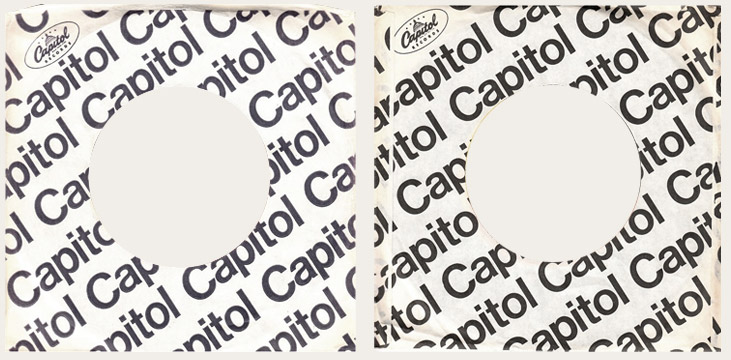
The same sleeve was also imported form the US and has references to the American Capitol record on the top left of the sleeve.
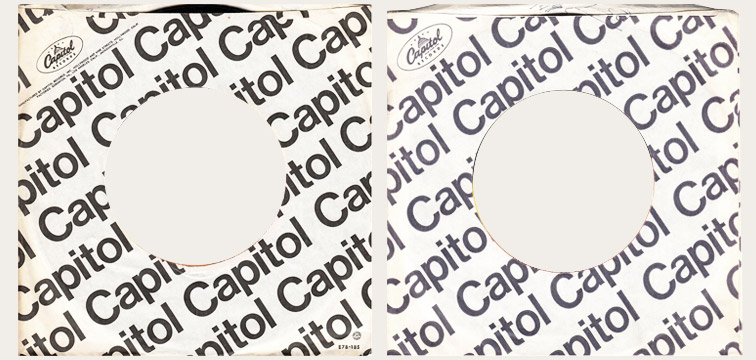
This white Apple sleeve is unique to Canada and was sused with non Beatles Apple releases. It is very fragile and is very difficult to find in good condition. By the latter part of 1970 though, the white sleeves were definitely not used anymore.

This white "Beatles on Apple" sleeve is unique to Canada and was sued with Beatles Apple releases. It is very fragile and is very difficult to find in good condition. This white sleeve was only used on Ballad Of John And Yoko and Something"/"Come Together. It is possible that the "Let It Be" and "Long And Winding Road" singles that were not sold in an imported picture sleeve might have been sold in a white sleeve, but this would need to be confirmed. By the latter part of 1970 though, the white sleeves were definitely not used anymore.
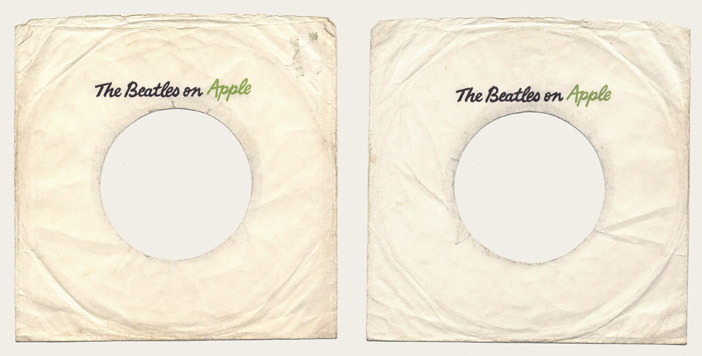
This glossy black "Beatles on Apple" sleeve has a straight edge and has been imported in small quantitites to be used with Apple Beatles releases such as "Hey Jude" and "Get Back". Source: Fred Young.

This glossy black apple sleeve has a straight edge and was used with Apple releases. "Hey Jude" and "Get Back" were issued in this sleeve.

This glossy black apple sleeve has a round edge and was used with Apple releases and appeared most likely after the staright cut sleeve.
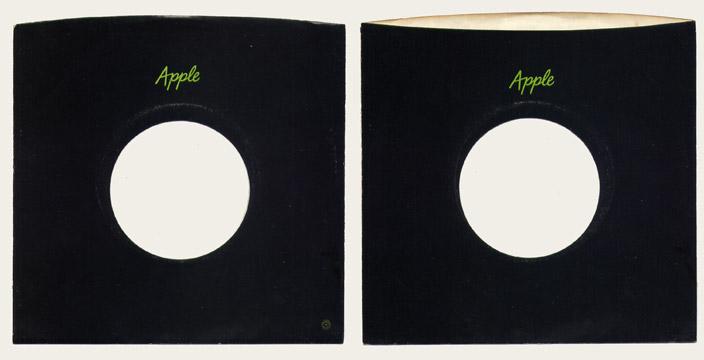
This flat black apple sleeve has a straight edge and was used with late Apple releases from around 1974 - 1975, like Whatever gets You Though The Night and This Guitar.
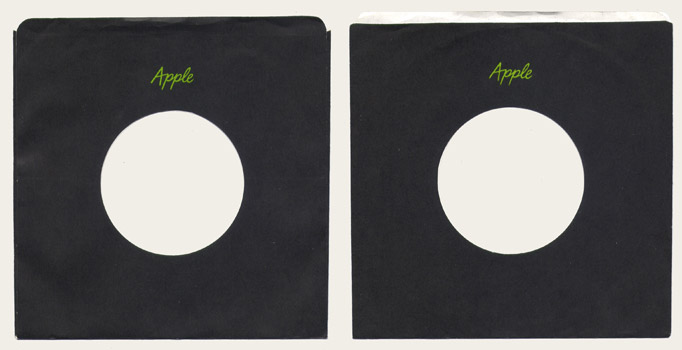
Here is a promotional sleeve used to send new releases to radio stations. BB means Billboard, CB means Cashbox and RPM is of course the Canadian mag from the 1970s. This sleeve was used with target label releases.

This sleeve was used with some of the new target labels at the time. It is identical on both sides.
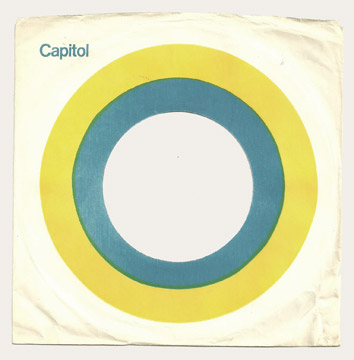
This sleeve was used a little later with the same target labels.It is identical on both sides.The sleeve on the right is the US version. As we can see it is a little different with its logo at the top left and the fabrication notice at the bottom.
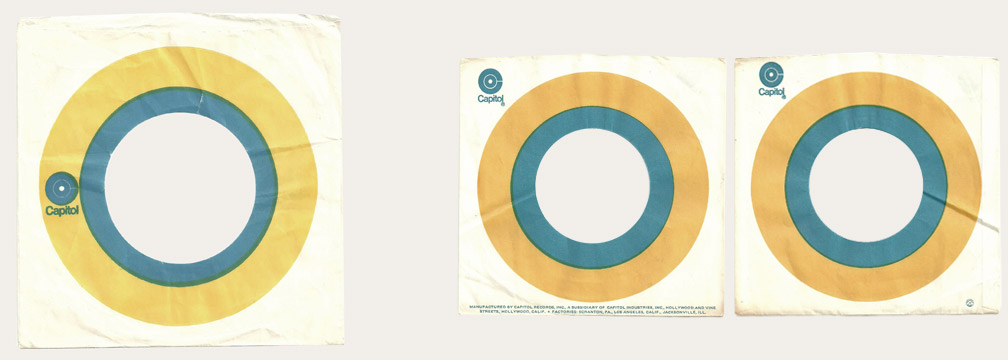
This red sleeve was used with later beige Starline reissues
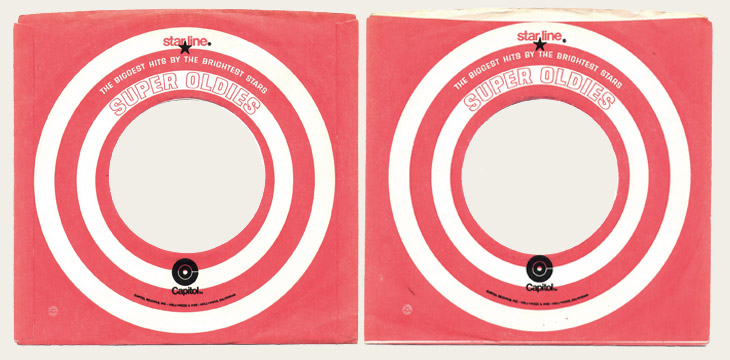
This Capitol "fade" sleeve was also used with some Target label 45s in roughly 1974 and 1975 on Capitol 72000's only, no records from other series like the 3000/4000 series were ever seen with this sleeve. It housed records of artists like Anne Murray, Edward Bear etc.
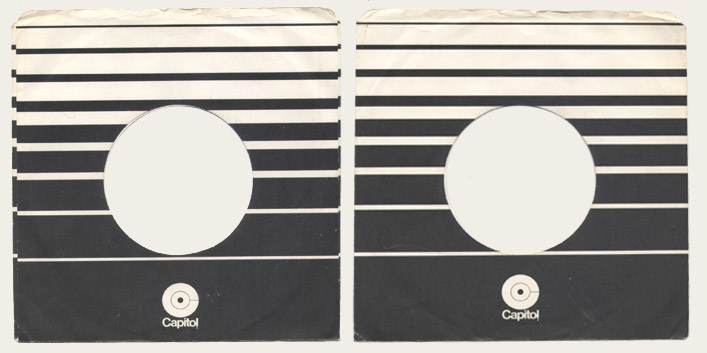
The orange label 45s all had this brown/orange sleeve except for 72000 series 45's in 1974-75 era. "Freedom For The Stallion" by Edward Bear (Capitol 72734) and "Just One Look" by Anne Murray (Capitol 72727) for example would have had the black and white sleeve. (see previous entry)
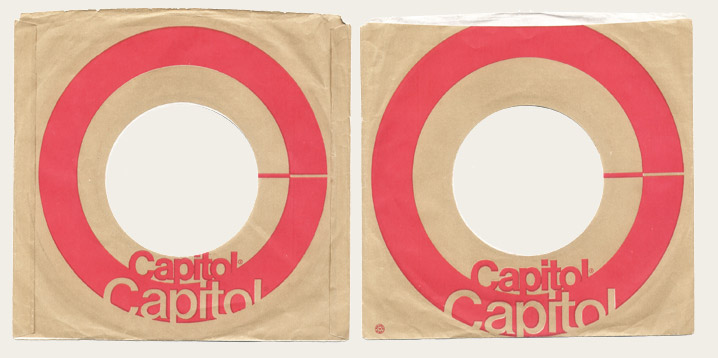
For the orange label Beatles reissues, Capitol created the "Beatles Forever Series" sleeve - all the same front, with a back side indicating the specefic title for the 45 is was meant to protect.
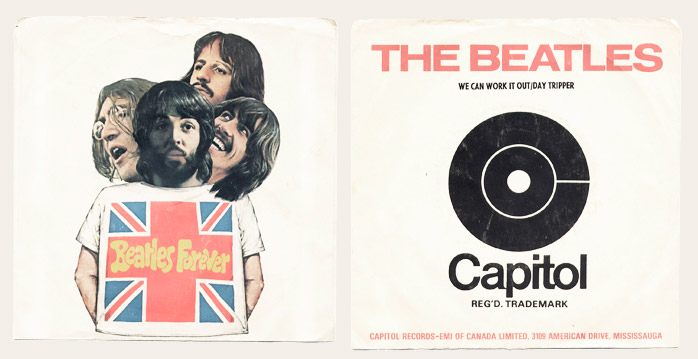
Other purple label records were sold in this silver sleeve with 8 Capitol logos displayed in a circlular manner. Some early purple labels in 1978, for example "You Needed Me" by Anne Murray still had the brown & orange sleeve but by about mid to fall 1978 this sleeve with the eight purple Capitol logos appeared
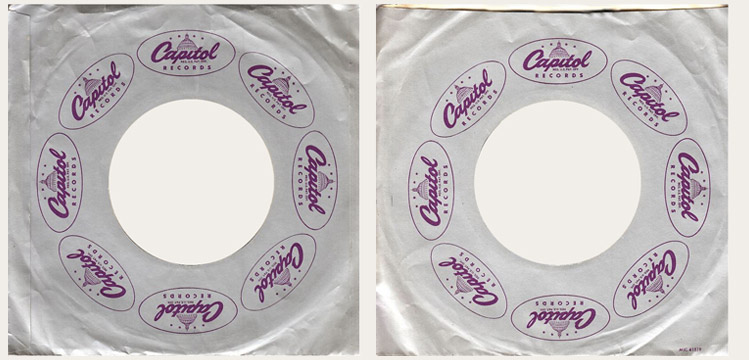
The same design was printed on a regular white paper sleeve around 1979, until late 1982.
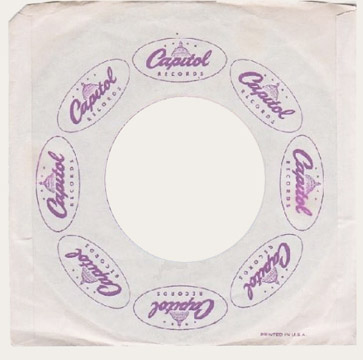
The Canadian purple label records then featured this plastic sleeve but only for a very short time since Capitol reverted to the retro rainbow label in 1983
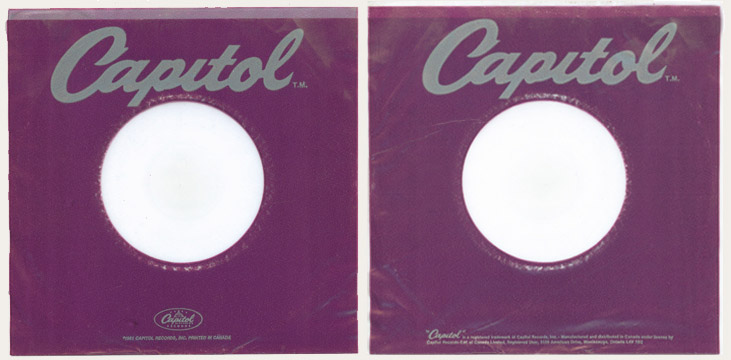
Similarly in the USA, records featured a glossy thick purple paper sleeve like this. This sleeve was imported for records that were not produced in Canada.

In mid 1983, the retro rainbow records were sold in this mylar checkered sleeve with a red logo.
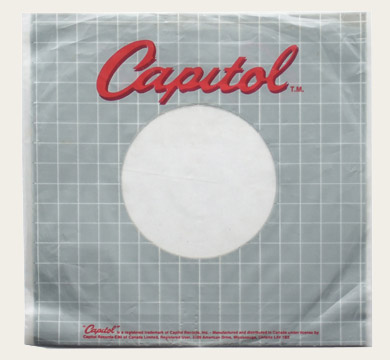
This sleeve with the white logo and grey background and white lines is American from 1988 and was issued with the once again "new" purple label of that period. It WAS however issued in Canada when Capitol began to issue some American pressings here, the best example of that being "Jealous Guy" by John Lennon.

This sleeve with the white logo was issued with the once again "new" purple label of that period. It WAS however issued in Canada when Capitol began to issue some American pressings here, the best example of that being "Jealous Guy" by John Lennon.
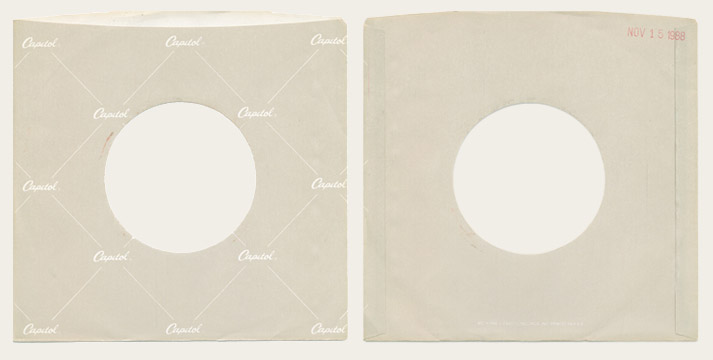
This black mylar Capitol sleeve was most likely in use from late 1987 until the label changed back to purple, probably the fall of 1988.

It was also available in cardboard for 12 inch singles, a format quite popular in the 80s.
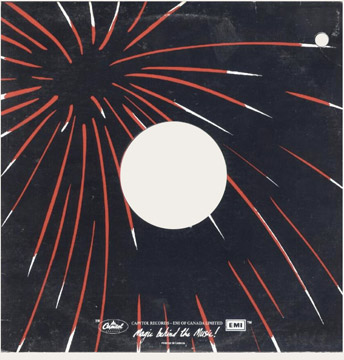
Another cardboard 12 inch sleeve was used in the 80s, but it was grey with the colorband on the left side.

The spotted silvery sleeve is American but again some were issued in Canada in 1989 whenever Capitol decided not to manufacture a record here. "The Doctor" by The Doobie Brothers (Capitol B-44376) and "Soldier Of Love" by Donny Osmond (Capitol B-44369) are a couple of examples that might have had that sleeve. Both those titles have had Canadian pressings a little later on. Ironically by 1989, Canadian Capitol purple label pressings had plain white sleeves.

EMI America records were sold in this logo checkered mylar sleeve. Note, the label seen here is not the right label for this sleeve.
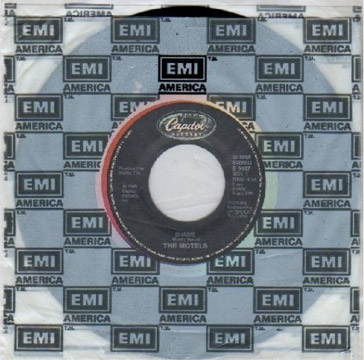
33 RPM album inner sleeves
This inner sleeve was widely used for mono albums and has a large circle with " A Word About High Fidelity" inside. The other side has a few words about this protective sleeve. The print is usually in GOLD color but has also been seen in simple black ink. This was the first sleeve used by Capitol of Canada, starting in 1959. Before this, no inner sleeves were used to house the records in the jacket.

This inner-sleeve was used in the late 50s, early 60s. This Canadian version is a cheaper black and white copy of the colorful US counterpart. Record covers almost look like drawing caricatures of the albums.
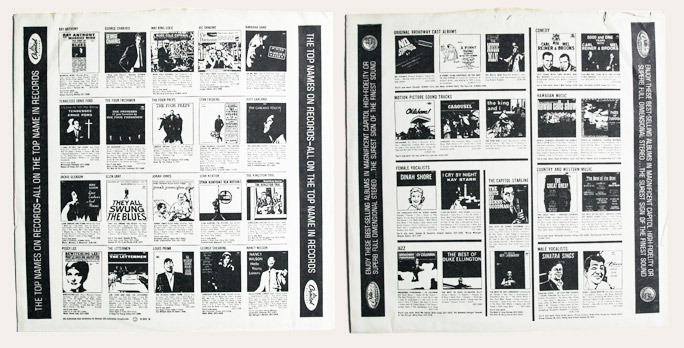
This inner-sleeve was used in early 60s for the Joan Hammond "Oh My Beloved Daddy" album. It promotes other albums of the time, it is black and White but of much higher quality as the firt sleeve from this list.

This green inner-sleeve was used in April 1963 for the Cliff Richards "Summer Holidays" album. It promotes other albums of the time. This inner sleeve was used with most STEREO releases.
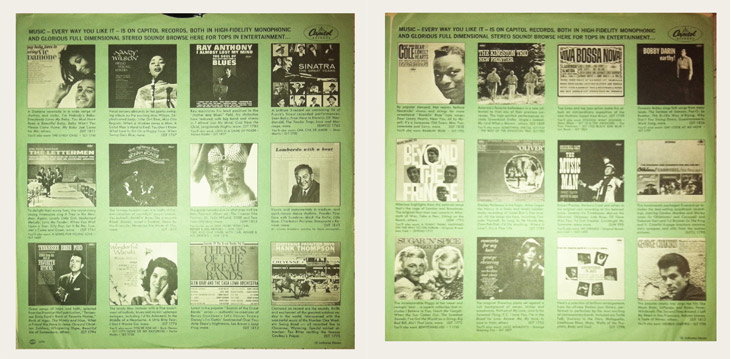
This sleeve was probably never used with Canadian records. It has been found in some jackets, but were most likely mismatched. This inner-sleeve was intended to explain the new idea of stereophonic recordings - one side promotes the "full Spectrum of Sound" while the other explains how stereophonic recordings are achieved.

This sleeve was probably never used with Canadian records. It has been found in some jackets, but were most likely mismatched. This other inner-sleeve was also intended to explain the new idea of stereophonic recordings - one side has color bars and two microphones over a text explaining Stereo recordings, while the other has a similar explicative piece on how it is made. This is one of the nicest colorful inner sleeves Capitol has produced!

This sleeve is probably the most popular Capitol sleeve for Canadian records. Known as the "red Pathé" sleeve, it served its purpose for most of the 6000 series during the early 60s. This sleeve was used for Capitol releases as well as Pathé and Angel releases.
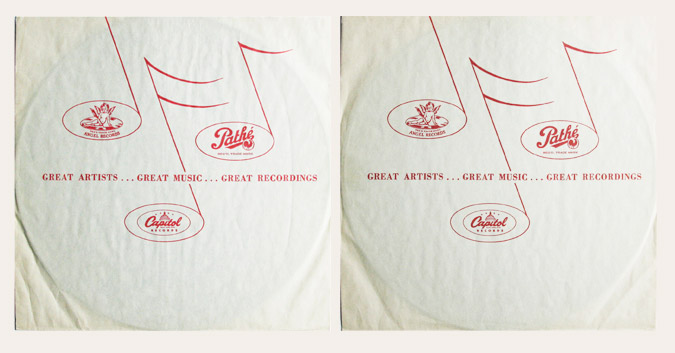
This other sleeve is quite similar to the previous one. Also known as a Red Pathé sleeve, it is more precisely refered to as the "Red Attention Sleeve". Used starting 1966 with albums such as Magical Mystery Tour by the Beatles, this sleeve featured a reminder to chnge your needle for longer preservation of our records. The reminder was in english on one side and in french on the other.
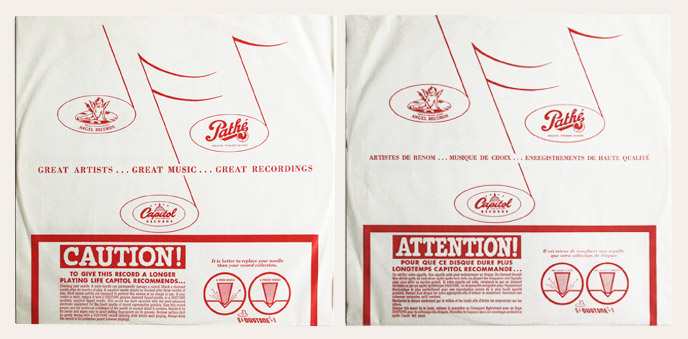
While Capitol offered interesting inner sleeves, sometimes the records were simply housed in a plain white paper inner sleeve. The White Album for example was issued in such sleeves.
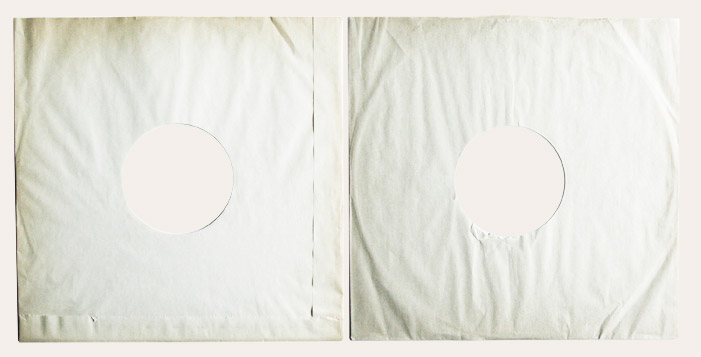
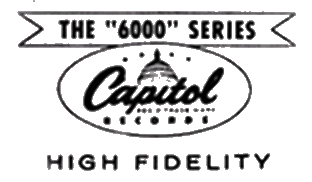
Copyright © 1999 - 2018
Capitol6000 & Hemmingsen Publishing
Piers A. Hemmingsen & Serge Pelletier. All Rights Reserved.